- DTC judgment completed
- System normal
| Last Modified: 08-28-2024 | 6.11:8.1.0 | Doc ID: RM100000000YSQ1 |
| Model Year Start: 2017 | Model: Sienna | Prod Date Range: [08/2016 - 11/2017] |
| Title: 2GR-FKS (ENGINE CONTROL): SFI SYSTEM: P042000,P043000; Catalyst System Efficiency Below Threshold Bank 1; 2017 MY Sienna [08/2016 - 11/2017] | ||
|
DTC |
P042000 |
Catalyst System Efficiency Below Threshold Bank 1 |
|
DTC |
P043000 |
Catalyst System Efficiency Below Threshold Bank 2 |
MONITOR DESCRIPTION
The ECM uses sensors mounted in front of and behind the Three-Way Catalytic Converter (TWC) to monitor its efficiency.
The first sensor, the air fuel ratio sensor, sends pre-catalyst information to the ECM. The second sensor, the heated oxygen sensor, sends post-catalyst information to the ECM.
In order to detect any deterioration in the three-way catalytic converter, the ECM calculates the oxygen storage capacity of the three-way catalytic converter. This calculation is based on the voltage output of the heated oxygen sensor while performing active air fuel ratio control.
The oxygen storage capacity value is an indication of the oxygen storage capacity of the three-way catalytic converter. When the vehicle is being driven with a warm engine, active air fuel ratio control is performed for approximately 30 seconds. When it is performed, the ECM deliberately sets the air fuel ratio to lean or rich levels. If the cycle of the waveform for the heated oxygen sensor is long, the oxygen storage capacity is great. There is a direct correlation between the heated oxygen sensor and the oxygen storage capacity of the three-way catalytic converter.
The ECM uses the oxygen storage capacity value to determine the state of the three-way catalytic converter. If any deterioration has occurred, the ECM will illuminate the MIL and store a DTC.
This system determines the deterioration of the entire catalyst system (including the front and rear catalysts), by using the oxygen storage capacity value of the front catalyst, that is more sensitive than the rear catalyst, as the representative value. Therefore, be sure to replace the front and rear catalysts together when catalyst replacement is necessary.
|
DTC No. |
Detection Item |
DTC Detection Condition |
Trouble Area |
MIL |
Memory |
Note |
|---|---|---|---|---|---|---|
|
P042000 |
Catalyst System Efficiency Below Threshold Bank 1 |
The oxygen storage capacity value is less than the standard value under active air fuel ratio control (1 trip detection logic: except Mexico models, 2 trip detection logic: for Mexico models). |
|
Comes on |
DTC stored |
|
|
P043000 |
Catalyst System Efficiency Below Threshold Bank 2 |
The oxygen storage capacity value is less than the standard value under active air fuel ratio control (1 trip detection logic: except Mexico models, 2 trip detection logic: for Mexico models). |
|
Comes on |
DTC stored |
|
CATALYST LOCATION
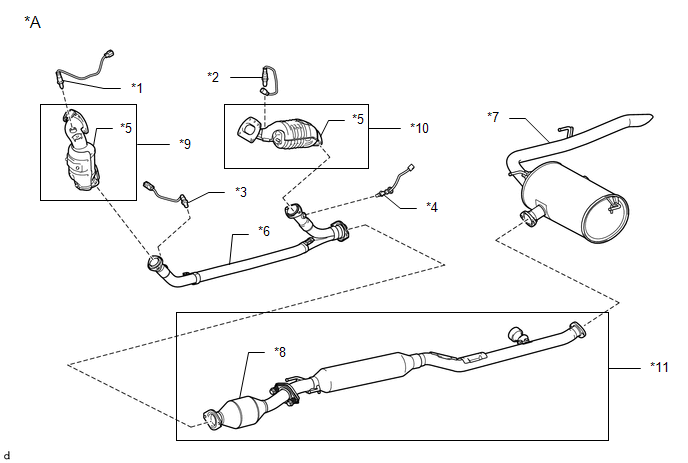
|
*A |
for 2WD |
- |
- |
|
*1 |
Air Fuel Ratio Sensor (Bank 2 Sensor 1) |
*2 |
Air Fuel Ratio Sensor (Bank 1 Sensor 1) |
|
*3 |
Heated Oxygen Sensor (Bank 2 Sensor 2) |
*4 |
Heated Oxygen Sensor (Bank 1 Sensor 2) |
|
*5 |
TWC: Front Catalyst |
*6 |
Front Exhaust Pipe Assembly |
|
*7 |
Tail Exhaust Pipe Assembly |
*8 |
TWC: Rear Catalyst |
|
*9 |
Exhaust Manifold Sub-assembly LH |
*10 |
Exhaust Manifold Sub-assembly RH |
|
*11 |
Center Exhaust Pipe Assembly |
- |
- |
NOTICE:
- When outputting DTC P042000 replace the exhaust manifold sub-assembly RH (*10) and the center exhaust pipe assembly (*11) together when catalyst replacement is necessary (Excluding air fuel ratio sensor *2 and heated oxygen sensor *4).
- When outputting DTC P043000 replace the exhaust manifold sub-assembly LH (*9) and the front exhaust pipe assembly (*11) together when catalyst replacement is necessary (Excluding air fuel ratio sensor *1 and heated oxygen sensor *3).
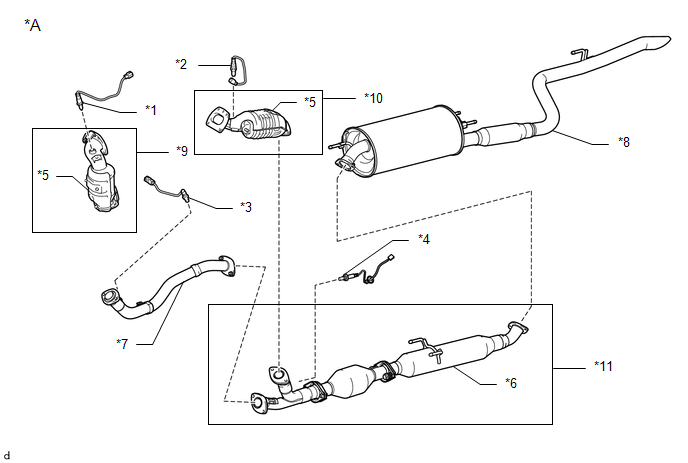
|
*A |
for AWD |
- |
- |
|
*1 |
Air Fuel Ratio Sensor (Bank 2 Sensor 1) |
*2 |
Air Fuel Ratio Sensor (Bank 1 Sensor 1) |
|
*3 |
Heated Oxygen Sensor (Bank 2 Sensor 2) |
*4 |
Heated Oxygen Sensor (Bank 1 Sensor 2) |
|
*5 |
TWC: Front Catalyst |
*6 |
TWC: Rear Catalyst |
|
*7 |
Front Exhaust Pipe Assembly |
*8 |
Tail Exhaust Pipe Assembly |
|
*9 |
Exhaust Manifold Sub-assembly LH |
*10 |
Exhaust Manifold Sub-assembly RH |
|
*11 |
Center Exhaust Pipe Assembly |
- |
- |
NOTICE:
- When outputting DTC P042000 replace the exhaust manifold sub-assembly RH (*10) and the center exhaust pipe assembly (*11) together when catalyst replacement is necessary (Excluding air fuel ratio sensor *2 and heated oxygen sensor *4).
- When outputting DTC P043000 replace the exhaust manifold sub-assembly LH (*9) and the front exhaust pipe assembly (*11) together when catalyst replacement is necessary (Excluding air fuel ratio sensor *1 and heated oxygen sensor *3).
MONITOR STRATEGY
|
Related DTCs |
P0420: Catalyst deterioration (bank 1) P0430: Catalyst deterioration (bank 2) |
|
Required Sensors/Components (Main) |
Air fuel ratio sensor Heated oxygen sensor |
|
Required Sensors/Components (Related) |
Intake air temperature sensor (mass air flow meter) Mass air flow meter Crankshaft position sensor Engine coolant temperature sensor |
|
Frequency of Operation |
Once per driving cycle |
|
Duration |
Approximately 30 seconds |
|
MIL Operation |
Immediate |
|
Sequence of Operation |
None |
TYPICAL ENABLING CONDITIONS
|
Monitor runs whenever the following DTCs are not stored |
P0010, P0020 (VVT oil control solenoid bank 1, 2) P0011, P0021 (VVT system bank 1, 2 - advance) P0012, P0022 (VVT system bank 1, 2 - retard) P0013, P0023 (Exhaust VVT oil control solenoid bank 1, 2) P0014, P0024 (Exhaust VVT system bank 1, 2 - advance) P0015, P0025 (Exhaust VVT system bank 1, 2 - retard) P0016, P0018 (VVT system bank 1, 2 - misalignment) P0017, P0019 (Exhaust VVT system bank 1, 2 - misalignment) P0031, P0032, P0051, P0052, P101D, P103D (Air fuel ratio sensor heater) P0037, P0038, P0057, P0058, P0141, P0161, P102D, P105D (Heated oxygen sensor heater) P0087, P0088, P0191, P0192, P0193 (Fuel pressure sensor (for high pressure side)) P0101, P0102, P0103 (Mass air flow meter) P0111, P0112, P0113 (Intake air temperature sensor) P0116, P0117, P0118 (Engine coolant temperature sensor) P011B (Engine coolant temperature/intake air temperature sensor correlation) P0121, P0122, P0123, P0222, P0223, P2135 (Throttle position sensor) P0125 (Insufficient coolant temperature for closed loop fuel control) P0128 (Thermostat) P0136, P0137, P0138, P0139, P013A, P013C, P0156, P0157, P0158, P0159, P0607 (Heated oxygen sensor) P014C, P014D, P014E, P014F, P015A, P015B, P015C, P015D, P2195, P2196, P2197, P2198, P2237, P2238, P2239, P2240, P2241, P2242, P2252, P2253, P2254, P2255, P2256 (Air fuel ratio sensor) P0171, P0172, P0174, P0175 (Fuel system) P0201, P0202, P0203, P0204, P0205, P0206, P062D, P21CF, P21D0, P21D1, P21D2, P21D3, P21D4 (Fuel injector) P0300 - P0306 (Misfire) P0327, P0328, P0332, P0333 (Knock sensor) P0335, P0337, P0338 (Crankshaft position sensor) P0340, P0342, P0343, P0345, P0347, P0348 (VVT sensor) P0351 - P0356 (Igniter) P0365, P0367, P0368, P0390, P0392, P0393 (Exhaust VVT sensor) P0443 (EVAP system) P0500 (Vehicle speed sensor) P0657, P2102, P2103, P2111, P2112, P2119 (Throttle actuator) P107B, P107C, P107D (Fuel pressure sensor (for low pressure side)) P11EA, P11EB, P11EC, P11ED, P11EE, P11EF, P11F0, P11F1, P219A, P219B, P219C, P219D, P219E, P219F, P21A0, P21A1 (Air-fuel ratio imbalance) P1235 (High pressure fuel pump circuit) |
|
Response rate during fuel cut from rich condition |
Completed |
|
Battery voltage |
11 V or higher |
|
Intake air temperature (for mass air flow meter) |
-10°C (14°F) or higher |
|
Engine coolant temperature |
75°C (167°F) or higher |
|
Atmospheric pressure |
76 kPa(abs) [11.02 psi(abs)] or higher |
|
Idling |
Off |
|
Engine speed |
Less than 3500 rpm |
|
Air fuel ratio sensor status |
Activated |
|
Fuel system status |
Closed loop |
|
Engine load |
10% or higher, and less than 100% |
|
Shift position |
3rd or higher |
|
All of the following conditions are met |
1, 2 and 3 |
|
1. Mass air flow rate |
5 gm/sec. or higher, and less than 95 gm/sec. |
|
2. Front catalyst temperature (estimated) |
580°C (1076°F) or higher, and less than 820°C (1508°F) |
|
3. Rear catalyst temperature (estimated) |
340°C (644°F) or higher, and less than 820°C (1508°F) |
TYPICAL MALFUNCTION THRESHOLDS
|
Oxygen Storage Capacity (OSC) of catalyst (Normalized) |
Less than 1 |
MONITOR RESULT
Refer to detailed information in Checking Monitor Status.
P0420: Catalyst Efficiency / O2 STORAGE B1
|
Monitor ID |
Test ID |
Scaling |
Unit |
Description |
|---|---|---|---|---|
|
$21 |
$AF |
Multiply by 0.001 |
No dimension |
Oxygen storage capacity of catalyst bank 1 (Normalization) |
P0430: Catalyst Efficiency / O2 STORAGE B2
|
Monitor ID |
Test ID |
Scaling |
Unit |
Description |
|---|---|---|---|---|
|
$22 |
$AF |
Multiply by 0.001 |
No dimension |
Oxygen storage capacity of catalyst bank 1 (Normalization) |
CONFIRMATION DRIVING PATTERN
HINT:
- It is necessary that the response of the heated oxygen sensor is normal in order to confirm DTCs P042000 and P043000. Therefore, perform the confirmation driving pattern for the heated oxygen sensor monitor before performing the drive pattern for the catalyst efficiency monitor.
- Performing this confirmation driving pattern will activate the catalyst efficiency monitor. This is very useful for verifying the completion of a repair.
- After repair has been completed, clear the DTC and then check that the vehicle has returned to normal by performing the following All Readiness check procedure.
- When clearing the permanent DTCs, refer to the "CLEAR PERMANENT DTC" procedure.
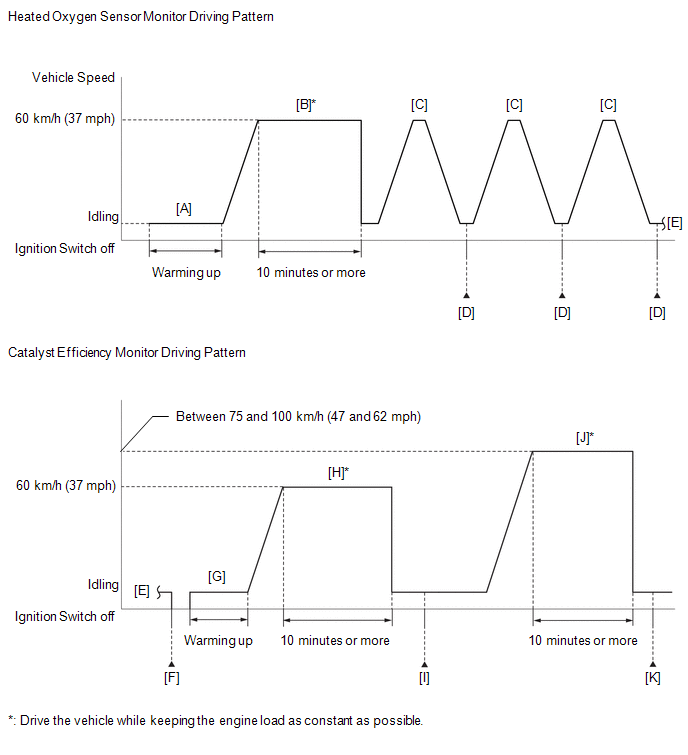
- Connect the Techstream to the DLC3.
- Turn the ignition switch to ON.
- Turn the Techstream on.
- Clear the DTCs (even if no DTCs are stored, perform the clear DTC procedure).
- Turn the ignition switch off and wait for at least 30 seconds.
- Turn the ignition switch to ON and turn the Techstream on.
- Enter the following menus: Powertrain / Engine / Monitor / Current Monitor.
- Check that Catalyst Efficiency / Current is Incomplete.
- Start the engine and warm it up until the engine coolant temperature is 75°C (167°F) or higher [A].
-
Drive the vehicle at approximately 60 km/h (37 mph) for 10 minutes or more [B].
CAUTION:
When performing the confirmation driving pattern, obey all speed limits and traffic laws.
HINT:
Drive the vehicle while keeping the engine load as constant as possible.
-
With the shift lever in S, drive the vehicle at 60 km/h (37 mph), and then decelerate the vehicle by releasing the accelerator pedal for 5 seconds or more to perform the fuel-cut [C].
CAUTION:
When performing the confirmation driving pattern, obey all speed limits and traffic laws.
- Enter the following menus: Powertrain / Engine / Monitor / Current Monitor / O2 Sensor / RL F/C B1S2, RL F/C B2S2 [D].
-
Check the Test Value for RL F/C B1S2, RL F/C B2S2.
- If Test Value displays a value larger than 0, perform the following procedure, as the O2 sensor monitor is finished.
- If Test Value displays 0, perform step [C] until it displays a value larger than 0, as the O2 sensor monitor is not finished.
- Turn the ignition switch off and wait for at least 30 seconds [F].
- Turn the ignition switch to ON and turn the Techstream on.
- Start the engine and warm it up until the engine coolant temperature is 75°C (167°F) or higher [G].
-
Drive the vehicle at approximately 60 km/h (37 mph) for 10 minutes or more [H].
CAUTION:
When performing the confirmation driving pattern, obey all speed limits and traffic laws.
HINT:
- Drive the vehicle while keeping the engine load as constant as possible.
- The monitor item will change to Complete as the Catalyst Efficiency monitor operates.
- Enter the following menus: Powertrain / Engine / Trouble Codes [I].
-
Check if any DTCs are stored.
HINT:
- If the monitor item does not change to Complete, and no DTCs are stored, perform the following procedure.
-
[A] to [I]: Normal judgment procedure.
The normal judgment procedure is used to complete DTC judgment and also used when clearing permanent DTCs.
- When clearing the permanent DTCs, do not disconnect the cable from the battery terminal or attempt to clear the DTCs during this procedure, as doing so will clear the universal trip and normal judgment histories.
-
Drive the vehicle at a speed between 75 and 100 km/h (47 and 62 mph) for 10 minutes or more [J].
CAUTION:
When performing the confirmation driving pattern, obey all speed limits and traffic laws.
HINT:
- Drive the vehicle while keeping the engine load as constant as possible.
- The monitor item will change to Complete as the Catalyst Efficiency monitor operates.
- Enter the following menus: Powertrain / Engine / Trouble Codes [K].
-
Check if any DTCs are stored.
HINT:
If the monitor item does not change to Complete, and no DTCs are stored, drive the vehicle again under an increased load.
- Enter the following menus: Powertrain / Engine / Utility / All Readiness.
- Input the DTC: P042000 or P043000.
-
Check the DTC judgment result.
Techstream Display
Description
NORMAL
ABNORMAL
- DTC judgment completed
- System abnormal
INCOMPLETE
- DTC judgment not completed
- Perform driving pattern after confirming DTC enabling conditions
HINT:
- If the judgment result is NORMAL, the system is normal.
- If the judgment result is ABNORMAL, the system has a malfunction.
-
[A] to [K]: Normal judgment procedure.
The normal judgment procedure is used to complete DTC judgment and also used when clearing permanent DTCs.
- When clearing the permanent DTCs, do not disconnect the cable from the battery terminal or attempt to clear the DTCs during this procedure, as doing so will clear the universal trip and normal judgment histories.
CONDITIONING FOR SENSOR TESTING
HINT:
Perform the operation with the engine speeds and time durations described below prior to checking the waveforms of the air fuel ratio and heated oxygen sensors. This is to activate the sensors sufficiently to obtain appropriate inspection results.
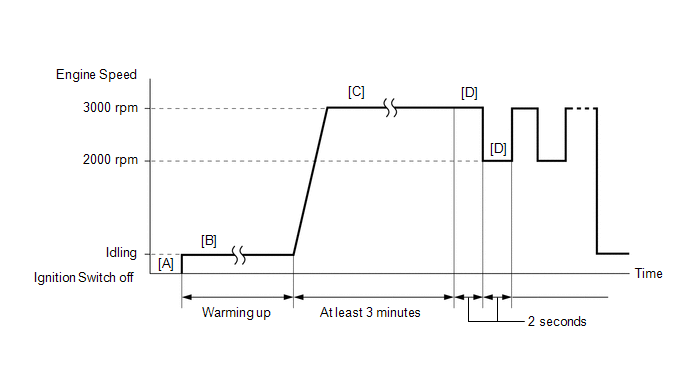
- Connect the Techstream to the DLC3.
- Turn the ignition switch to ON and turn the Techstream on [A].
- Start the engine and warm it up with all the accessories switched off until the engine coolant temperature stabilizes [B].
- Enter the following menus: Powertrain / Engine / Data List / A/F (O2) Sensor Voltage B1S1 and O2 Sensor Voltage B1S2 or A/F (O2) Sensor Voltage B2S1 and O2 Sensor Voltage B2S2.
- Run the engine at an engine speed of between 2500 rpm and 3000 rpm for at least 3 minutes [C].
- While running the engine at 3000 rpm for 2 seconds, and then 2000 rpm for 2 seconds, check the waveforms of the air fuel ratio and heated oxygen sensors using the Techstream [D].
HINT:
- If the voltage output of either the air fuel ratio or heated oxygen sensor does not fluctuate, or there is a noise in the waveform of either sensor, the sensor may be malfunctioning.
- If the voltage outputs of both the sensors remain lean or rich, the air fuel ratio may be extremely lean or rich. In such cases, perform the Control the Injection Volume for A/F Sensor Active Test using the Techstream.
- If the Three-way Catalytic Converter (TWC) has deteriorated, the heated oxygen sensor (located behind the Three-way Catalytic Converter [TWC]) voltage output fluctuates up and down frequently, even under normal driving conditions (active air fuel ratio control is not performed).
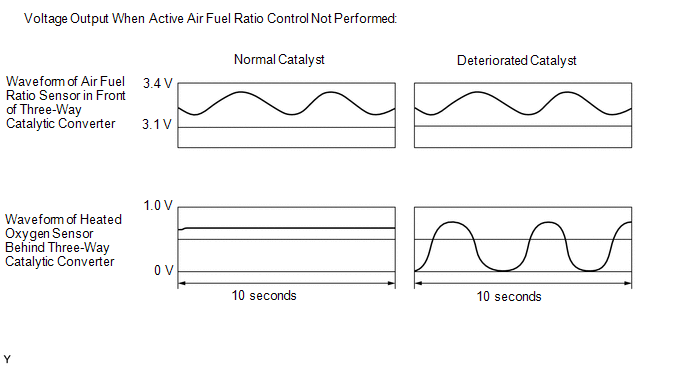
CAUTION / NOTICE / HINT
HINT:
- If a malfunction cannot be found when troubleshooting DTC P042000 or P043000, a lean or rich abnormality may be the cause. Perform troubleshooting by following the inspection procedure for P017100 or P017400 (System Too Lean), and P017200 or P017500 (System Too Rich).
-
Bank 1 refers to the bank that includes the No. 1 cylinder*.
*: The No. 1 cylinder is the cylinder which is farthest from the transaxle.
- Bank 2 refers to the bank that does not include the No. 1 cylinder.
- Sensor 1 refers to the sensor closest to the engine assembly.
- Sensor 2 refers to the sensor farthest away from the engine assembly.
- Read freeze frame data using the Techstream. The ECM records vehicle and driving condition information as freeze frame data the moment a DTC is stored. When troubleshooting, freeze frame data can help determine if the vehicle was moving or stationary, if the engine was warmed up or not, if the air fuel ratio was lean or rich, and other data from the time the malfunction occurred.
PROCEDURE
|
1. |
CHECK ANY OTHER DTCS OUTPUT (IN ADDITION TO DTC P042000 AND/OR P043000) |
(a) Connect the Techstream to the DLC3.
(b) Turn the ignition switch to ON.
(c) Turn the Techstream on.
(d) Enter the following menus: Powertrain / Engine / Trouble Codes.
(e) Read the DTCs.
|
Result |
Proceed to |
|---|---|
|
DTC P042000 and/or P043000 are output |
A |
|
DTC P042000 and/or P043000 and other DTCs are output |
B |
HINT:
If any DTCs other than P042000 and/or P043000 are output, troubleshoot those DTCs first.
| B |

|
|
|
2. |
PERFORM ACTIVE TEST USING TECHSTREAM (CONTROL THE INJECTION VOLUME FOR A/F SENSOR) |
(a) Connect the Techstream to the DLC3.
(b) Start the engine and warm it up.
(c) Turn the Techstream on.
(d) Run the engine at an engine speed of 2500 rpm for approximately 90 seconds.
(e) Enter the following menus: Powertrain / Engine / Active Test / Control the Injection Volume for A/F Sensor / Data List / A/F (O2) Sensor Voltage B1S1 and O2 Sensor Voltage B1S2 or A/F (O2) Sensor Voltage B2S1 and O2 Sensor Voltage B2S2.
(f) Perform the Active Test operation with the engine idling (change the fuel injection volume).
(g) Monitor the voltage outputs of the air fuel ratio sensor and heated oxygen sensor (A/F (O2) Sensor Voltage B1S1 and O2 Sensor Voltage B1S2 or A/F (O2) Sensor Voltage B2S1 and O2 Sensor Voltage B2S2) displayed on the Techstream.
HINT:
- The Control the Injection Volume for A/F Sensor operation lowers the fuel injection volume by 12.5% or increases the injection volume by 12.5%.
- Each sensor reacts in accordance with increases and decreases in the fuel injection volume.
- The air fuel ratio sensor has an output delay of a few seconds and the heated oxygen sensor has a maximum output delay of approximately 20 seconds.
- If the sensor output voltage does not change (almost no reaction) while performing the Active Test, the sensor may be malfunctioning.
Standard:
|
Techstream Display (Sensor) |
Injection Volume |
Status |
Voltage |
|---|---|---|---|
|
A/F (O2) Sensor Voltage B1S1 A/F (O2) Sensor Voltage B2S1 (Air fuel ratio) |
12.5% |
Rich |
Below 3.1 V |
|
-12.5% |
Lean |
Higher than 3.4 V |
|
|
O2 Sensor Voltage B1S2 O2 Sensor Voltage B2S2 (Heated oxygen) |
12.5% |
Rich |
Higher than 0.55 V |
|
-12.5% |
Lean |
Below 0.4 V |
|
Status of A/F (O2) Sensor Voltage B1S1 or A/F (O2) Sensor Voltage B2S1 |
Status of O2 Sensor Voltage B1S2 or O2 Sensor Voltage B2S2 |
Actual air fuel ratio, air fuel ratio sensor and heated oxygen sensor condition |
Misfire |
Main Suspected Trouble Area |
Proceed to |
|---|---|---|---|---|---|
|
Lean/Rich |
Lean/Rich |
Normal |
- |
|
A |
|
Lean |
Lean/Rich |
Air fuel ratio sensor malfunction |
- |
|
B |
|
Rich |
Lean/Rich |
Air fuel ratio sensor malfunction |
- |
|
|
|
Lean/Rich |
Lean |
Heated oxygen sensor malfunction |
- |
|
C |
|
Lean/Rich |
Rich |
Heated oxygen sensor malfunction |
- |
|
|
|
Lean |
Lean |
Actual air fuel ratio lean |
May occur |
|
D |
|
Rich |
Rich |
Actual air fuel ratio rich |
- |
|
- Lean: During Control the Injection Volume for A/F Sensor, the air fuel ratio sensor output voltage (A/F (O2) Sensor Voltage B1S1 or A/F (O2) Sensor Voltage B2S1) is consistently higher than 3.4 V, and the heated oxygen sensor output voltage (O2 Sensor Voltage B1S2 or O2 Sensor Voltage B2S2) is consistently less than 0.4 V.
- Rich: During Control the Injection Volume for A/F Sensor, the A/F (O2) Sensor Voltage B1S1 or A/F (O2) Sensor Voltage B2S1 is consistently less than 3.1 V, and the O2 Sensor Voltage B1S2 or O2 Sensor Voltage B2S2 is consistently higher than 0.55 V.
- Lean/Rich: During Control the Injection Volume for A/F Sensor of the Active Test, the output voltage of the air fuel ratio sensor or heated oxygen sensor alternates correctly.
| B |

|
| C |

|
| D |

|
|
|
3. |
CHECK FOR EXHAUST GAS LEAK |
(a) Check for exhaust gas leaks.
OK:
No gas leaks.
| OK |

|
| NG |

|
|
4. |
REPLACE AIR FUEL RATIO SENSOR |
(a) Replace the air fuel ratio sensor.
HINT:
Perform "Inspection After Repair" after replacing the air fuel ratio sensor.
| NEXT |

|
|
5. |
CHECK FOR EXHAUST GAS LEAK |
(a) Check for exhaust gas leaks.
OK:
No gas leaks.
| NG |

|
|
|
6. |
REPLACE HEATED OXYGEN SENSOR |
(a) Replace the heated oxygen sensor.
HINT:
Perform "Inspection After Repair" after replacing the heated oxygen sensor.
| NEXT |

|
|
7. |
CHECK FOR EXHAUST GAS LEAK |
(a) Check the exhaust gas leaks.
OK:
No gas leaks.
| NG |

|
|
|
8. |
CHECK CAUSE OF EXTREMELY RICH OR LEAN ACTUAL AIR FUEL RATIO |
(a) Check the cause of extremely rich or lean actual air fuel ratio, referring to the DTC P017100 Inspection Procedure.
| NEXT |

|
|
9. |
REPAIR OR REPLACE EXHAUST GAS LEAK POINT |
(a) Repair or replace exhaust gas leak point.
HINT:
Perform "Inspection After Repair" after repairing or replacing the exhaust system.
|
|
10. |
CHECK WHETHER DTC OUTPUT RECURS (DTC P042000 AND/OR P043000) |
(a) Connect the Techstream to the DLC3.
(b) Turn the ignition switch to ON.
(c) Turn the Techstream on.
(d) Clear the DTCs.
(e) Turn the ignition switch off and wait for at least 30 seconds.
(f) Turn the ignition switch to ON.
(g) Turn the Techstream on.
(h) Start the engine.
(i) Drive the vehicle in accordance with the driving pattern described in Confirmation Driving Pattern.
(j) Enter the following menus: Powertrain / Engine / Trouble Codes.
(k) Read the DTCs.
|
Result |
Proceed to |
|---|---|
|
DTCs are not output (No pending DTCs output) |
A |
|
DTC P042000 and/or P043000 are output |
B |
| A |

|
END |
|
|
11. |
CHECK DTC OUTPUT (DTC P042000 AND/OR P043000) |
NOTICE:
- If DTC P042000 is output, replace the exhaust manifold (TWC: Front catalyst) and the center exhaust pipe assembly (TWC: Rear catalyst) together when catalyst replacement is necessary.
- If DTC P043000 is output, replace the exhaust manifold assembly LH (TWC: Front catalyst) and the center exhaust pipe assembly (TWC: Rear catalyst) together when catalyst replacement is necessary.
HINT:
Confirm the replacement parts, referring to the illustration in Catalyst Location.
(a) Connect the Techstream to the DLC3.
(b) Turn the ignition switch to ON.
(c) Turn the Techstream on.
(d) Enter the following menus: Powertrain / Engine / Trouble Codes.
(e) Read the DTCs.
|
Result |
Vehicle Type |
Proceed to |
|---|---|---|
|
DTC P042000 is output |
2WD |
A |
|
AWD |
B |
|
|
DTC P043000 is output |
2WD |
C |
|
AWD |
D |
|
|
DTC P042000 and P043000 are output |
2WD |
E |
|
AWD |
F |
| B |

|
| C |

|
| D |

|
| E |

|
| F |

|
|
|
12. |
REPLACE EXHAUST MANIFOLD SUB-ASSEMBLY RH (TWC: FRONT CATALYST) |
| NEXT |

|
|
13. |
REPLACE EXHAUST MANIFOLD SUB-ASSEMBLY RH (TWC: FRONT CATALYST) |
| NEXT |

|
|
14. |
REPLACE EXHAUST MANIFOLD SUB-ASSEMBLY LH (TWC: FRONT CATALYST) |
| NEXT |

|
|
15. |
REPLACE EXHAUST MANIFOLD SUB-ASSEMBLY LH (TWC: FRONT CATALYST) |
| NEXT |

|
|
16. |
REPLACE EXHAUST MANIFOLD SUB-ASSEMBLY RH (TWC: FRONT CATALYST) |
|
|
17. |
REPLACE EXHAUST MANIFOLD SUB-ASSEMBLY LH (TWC: FRONT CATALYST) |
| NEXT |

|
|
18. |
REPLACE EXHAUST MANIFOLD SUB-ASSEMBLY RH (TWC: FRONT CATALYST) |
|
|
19. |
REPLACE EXHAUST MANIFOLD SUB-ASSEMBLY LH (TWC: FRONT CATALYST) |
| NEXT |

|
|
|
|
![2017 - 2020 MY Sienna [08/2016 - ]; 2GR-FKS (ENGINE CONTROL): SFI SYSTEM: CHECKING MONITOR STATUS](/t3Portal/stylegraphics/info.gif)
